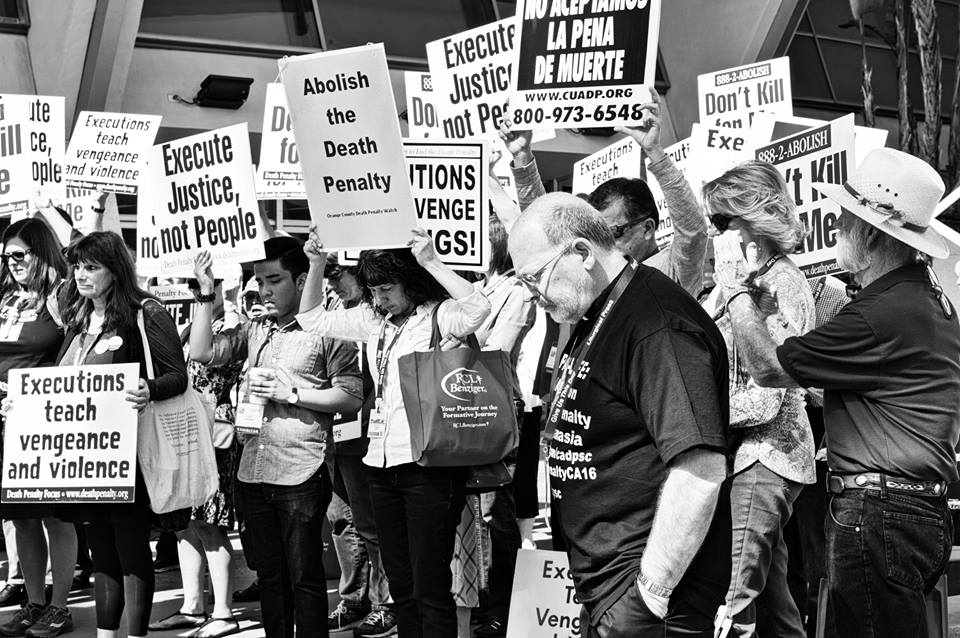Death Penalty
On August 1 it was announced that Pope Francis changed the catechism of the Catholic Church to make the death penalty unacceptable. On October 27, a shooter killed eleven people worshipping in a synagogue in Pittsburgh. I have wanted to write about the death penalty since the Pope’s proclamation, but first the sex abuse crisis and then the youth synod intervened. Now is the time.

Catholics Against Death Penalty – Southern California
As I write this, only the federal crimes have been charged in Pittsburgh, but I heard on NPR that only three people have been sentenced to death on the federal level since the 1960s. Usually the states try murders and other felonies and impose the sentence. Since he took office, Governor Wolf has refused to enforce the death penalty in Pennsylvania. But now these crimes seem so egregious, people are talking about it. How will you feel? Beyond, of course, the terrible sadness of this tragedy.
Originally, my intention was to comment on Frank DeBernardo’s August 3 blog in Bondings. He asks “What Does Change in Church’s Death Penalty Teaching Mean for LGBT People?” and answers, “Church teaching can change.” Those explaining the doctrine for the Vatican News Service note that this teaching “is not in contradiction with the prior teachings of the Magisterium.” Frank asks, even if it’s just the opposite? The explanation is that the prior understanding was that it was the “responsibility of the public authority to protect the common good in a social context in which the penal sanctions were understood differently,” among other reasons. Changing social context is why New Ways Ministry exists, to argue for “justice and equality for lesbian, gay, bisexual, and transgender (LGBT) Catholics, and reconciliation within the larger church and civil communities.” Frank finds that one of the most positive effects of this new teaching is the condemnation of the death penalty as it is imposed against LGBT people “in nations where they are criminalized.” Yes, that exists.
WOC’s social context has changed, too, dear Vatican, and it was early in the 20th century. St. Joan’s Alliance was formed then in the English-speaking world, and WOC came along in 1975. I will remind you of the current phrasing of why WOC exists: “To advocate and pray for the ordination and the full equality of women in an inclusive and accountable Roman Catholic Church.” There’s lots more about this on the web site, but I will go on to say that John Paul II/Cardinal Ratzinger felt it necessary to forbid discussion of women’s ordination. Frank’s very hopeful sentiment about change is not available to women wanting ordination. We are the only ones whose aspirations are subject to a spiritual death sentence, if you will. Women are really scary.
But are things changing for women? You do know that the youth at the recent Synod got the Bishops to dance around gender and sexuality issues a little more energetically than they have before. And the committee on deacons may come back from its apparent state of rigor mortis.
Not everyone is happy with the change about the death penalty. This is not surprising, given Catholic public opinion:
According to a 2016 poll by the Pew Research Center, 46 percent of U.S. Catholics oppose the death penalty for those convicted of murder, while 43 percent support it. (Among white Catholics, 54 percent support the death penalty while 39 percent oppose it.)
What does that tell you about how racialized first-hand experience with the American justice system is? But I won’t go there today. Rather, I will note how differently four articles in Commonweal approach the topic.
Helen Prejean, CSJ, the most well-known Catholic on the death penalty because of her advocacy and accompaniment, is interviewed by John Gehring. She understands the process of change as the inevitable victory of Catholic social justice teaching.
Cathleen Kaveny teaches law and theology, and presents a carefully-reasoned treatment of the decision, She does clarify that “inadmissible” is a better word for the ban in Italian than in English.
Senior writer Paul Baumann begins with the Holocaust and Hannah Arendt to examine the most moral punishment for murder; he can raise theoretical arguments for death in the most extreme cases while objecting to it as a matter of practice. He concludes by pushing Frank’s insight further. Do we want such momentous decisions made by the Pope alone or by “an ecumenical council”? He notes the irony that in this case liberals support the fiat and conservatives argue for what I might call the “sensus fidelium.”
Finally, Paul Moses begins with a humorous take on the same point:
From the quick reaction in some quarters to the Vatican’s announcement that the Catechism of the Catholic Church will henceforth state that the death penalty is “inadmissible,” one might think Pope Francis had just ordered the execution of a lineup of conservative theologians.
Then he circles back to the key argument for the end of the death penalty: the dignity of every human life and the respect for all people required by the Gospel. This is the heart of our faith and the reason we work for everything we do.

2 Responses
The faith is always the same yet the source of ever new light. JP2’s Theology of the Body is key to understand that the ordination of women does not change anything essential; it just enables us to see the sacramental economy in a new light.
Summary Points for Meditation on the Ordination of Women
http://pelicanweb.org/CCC.TOB.html#SUMMARY
Thank you, Regina! So on target with WOC’s goals and also with the state of the world.